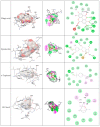In Vitro and In Silico Activities of E. radiata and E. cinerea as an Enhancer of Antibacterial, Antioxidant, and Anti-Inflammatory Agents - PubMed
- ️Sun Jan 01 2023
In Vitro and In Silico Activities of E. radiata and E. cinerea as an Enhancer of Antibacterial, Antioxidant, and Anti-Inflammatory Agents
Hayet Elkolli et al. Molecules. 2023.
Abstract
Eucalyptus, a therapeutic plant mentioned in the ancient Algerian pharmacopeia, specifically two species belonging to the Myrtaceae family, E. radiata and E. cinerea, were investigated in this study for their antibacterial, antioxidant, and anti-inflammatory properties. The study used aqueous extracts (AE) obtained from these plants, and the extraction yields were found to be different. The in vitro antibacterial activity was evaluated using a disc diffusion assay against three typical bacterial strains. The results showed that the two extracts were effective against all three strains. Both extracts displayed significant antioxidant activity compared to BHT. The anti-inflammatory impact was evaluated using a protein (BSA) inhibition denaturation test. The E. radiata extract was found to inhibit inflammation by 85% at a concentration of 250 µg/mL, significantly higher than the Aspirin. All phytoconstituents present good pharmacokinetic characteristics without toxicity except very slight toxicity of terpineol and cineol and a maximum binding energy of -7.53 kcal/mol for its anti-TyrRS activity in silico. The study suggests that the extracts and their primary phytochemicals could enhance the efficacy of antibiotics, antioxidants, and non-steroidal anti-inflammatory drugs (NSAIDs). As pharmaceutical engineering experts, we believe this research contributes to developing natural-based drugs with potential therapeutic benefits.
Keywords: Eucalyptus cinerea; Eucalyptus radiata; anti-inflammatory activity; antibacterial activity; antioxidant activity.
Conflict of interest statement
The authors declare no conflict of interest.
Figures

DPPH scavenging effect of the AEs and this of BHT.

Inhibition of protein denaturation by the extracts and aspirin (p < 0.05), ns: non-significant, *: Slightly significant difference.

Interaction and bond distances of ligands inside the active site pocket as shown by molecular surface maps.

Interaction and bond distances of ligands inside the active site pocket as shown by molecular surface maps.

The most commonly used species, plant parts, and methods of preparation.

(a) E. radiata, (b) E. cinerea.

The TyrRS (1JII) crystal structure and the 2D structures of the tested compounds.
Similar articles
-
Sithisarn P, Nantateerapong P, Rojsanga P, Sithisarn P. Sithisarn P, et al. Molecules. 2016 Apr 7;21(4):446. doi: 10.3390/molecules21040446. Molecules. 2016. PMID: 27070560 Free PMC article.
-
Gómez-Rivera A, González-Cortazar M, Herrera-Ruíz M, Zamilpa A, Rodríguez-López V. Gómez-Rivera A, et al. J Ethnopharmacol. 2018 May 10;217:212-219. doi: 10.1016/j.jep.2018.02.012. Epub 2018 Feb 16. J Ethnopharmacol. 2018. PMID: 29458147
-
Sidhic J, George S, Alfarhan A, Rajagopal R, Olatunji OJ, Narayanankutty A. Sidhic J, et al. Molecules. 2023 Sep 29;28(19):6875. doi: 10.3390/molecules28196875. Molecules. 2023. PMID: 37836717 Free PMC article.
-
Phytochemical and pharmacological aspects of Salvia mirzayanii Rech. f. & Esfand.
Zarshenas MM, Krenn L. Zarshenas MM, et al. J Evid Based Complementary Altern Med. 2015 Jan;20(1):65-72. doi: 10.1177/2156587214553938. Epub 2014 Oct 19. J Evid Based Complementary Altern Med. 2015. PMID: 25331096 Review.
-
König S. König S. Molecules. 2024 Jun 14;29(12):2847. doi: 10.3390/molecules29122847. Molecules. 2024. PMID: 38930911 Free PMC article. Review.
References
-
- Abouzkhar F.A., Yangui I., Messaoud C., Ben Jamâa M.L. Eucalyptus Leaf Diseases Associated with Neofusicoccum spp. in North Africa. J. Arid Environ. 2022;197:104662. doi: 10.1016/j.jaridenv.2021.104662. - DOI
MeSH terms
Substances
Grants and funding
This research was funded by the Deputyship for Research & Innovation, Ministry of Education in Saudi Arabia (IFKSURC-1-0823).
LinkOut - more resources
Full Text Sources
Medical
Research Materials